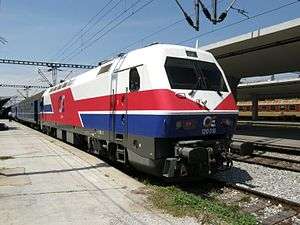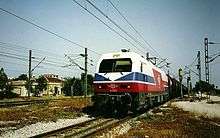OSE class 120
OSE Class 120, also known as HellasSprinter is the first class of electric locomotives in Greece, operated by TrainOSE and Rail Cargo Logistics Goldair (120 007).[1] Is part of OSE's rolling stock. The first six were built in 1999 as class H.561 and the remaining 24 between 2004 and 2005 by Siemens and Krauss-Maffei. In total, there are 30 such locomotives, numbered 120 001-120 030, most of which perform services on the Athens-Thessaloniki-Edomeni line.[2] Some units are preserved at Thessaloniki Depot in Menemeni They feature electric motors with combined power of 5,000 kW[3], making the locomotives capable of speeds up to 200 kilometers per hour.[3]
| OSE Class 120 (Hellas Sprinter) | |||||||||||||||||||||
|---|---|---|---|---|---|---|---|---|---|---|---|---|---|---|---|---|---|---|---|---|---|
 120-016 enters Thessaloniki New Passenger Station with train 335 from Belgrade in 2008. | |||||||||||||||||||||
| |||||||||||||||||||||
| |||||||||||||||||||||
| |||||||||||||||||||||
| |||||||||||||||||||||
Route

Today all units except the first 4 (26) are in circulation. Active units serve long-distance trains on the Piraeus-Thessaloniki route, in the section from Athens to Thessaloniki[4] and local / international trains on the Thessaloniki-Skopje line, as well as commercial trains. 120 001[5], 120 002[6], and 120 002[7], as well as H.564 due to accident[8], are preserved.
List of locomotives
The following table summarizes the class[3]
| OSE Number | Old OSE number | Year | Manufacturer | S/N | Notes |
|---|---|---|---|---|---|
| 120 001 | H-561 | 1997 | Krauss-Maffei | 20323 | |
| 120 002 | H-562 | 1997 | Krauss-Maffei | 20324 | |
| 120 003 | H-563 | 1997 | Krauss-Maffei | 20325 | |
| 120 004 | H-564 | 1997 | Krauss-Maffei | 20326 | Out of order after derailment (2000) |
| 120 005 | H-565 | 1997 | Krauss-Maffei | 20327 | |
| 120 006 | H-566 | 1997 | Krauss-Maffei | 20328 | |
| 120 007 | 2004 | Siemens | 20645 | ||
| 120 008 | 2004 | Siemens | 20646 | ||
| 120 009 | 2004 | Siemens | 20647 | ||
| 120 010 | 2004 | Siemens | 20648 | ||
| 120 011 | 2004 | Siemens | 20649 | ||
| 120 012 | 2004 | Siemens | 20650 | ||
| 120 013 | 2004 | Siemens | 20651 | ||
| 120 014 | 2004 | Siemens | 20652 | ||
| 120 015 | 2004 | Siemens | 20653 | ||
| 120 016 | 2004 | Siemens | 20654 | ||
| 120 017 | 2004 | Siemens | 20655 | ||
| 120 018 | 2004 | Siemens | 20656 | ||
| 120 019 | 2004 | Siemens | 20657 | ||
| 120 020 | 2004 | Siemens | 20658 | ||
| 120 021 | 2004 | Siemens | 20659 | ||
| 120 022 | 2004 | Siemens | 20660 | ||
| 120 023 | 2004 | Siemens | 20661 | ||
| 120 024 | 2004 | Siemens | 20662 | ||
| 120 025 | 2004 | Siemens | 20663 | ||
| 120 026 | 2004 | Siemens | 20664 | ||
| 120 027 | 2004 | Siemens | 20665 | ||
| 120 028 | 2004 | Siemens | 20666 | ||
| 120 029 | 2004 | Siemens | 20667 | ||
| 120 030 | 2005 | Siemens | 20668 |
History[3]
1990s
In January 1996, the Hellenic Railways Organization (OSE) decided to order under the 1997 Program Agreements[9], six high-performance helectric locomotives from Siemens and KraussMaffei, with a total value of more than 235 million euros. Construction was done in 17 months. These locomotives are based on the EuroSprinter, from which got the name "Hellas Sprinter". Their particular feature was that because their weight should not exceed 80 metric tons, they were the lightest design in its performance class.
Although it was based on EuroSprinter Classic, it brought some differences:
- It has no rear mirrors
- the cab side windows have a different shape
- the locomotives have top head lights
- only six grids at the top of each locomotive remained
The first six units were delivered by the end of 1999, and were numbered H 561 to H 566 (H meant Ηλεκτράμαξα, Helectric Locomotive) and later renamed "120 001" to "120 006". They were used for the first time from Thessaloniki to the border of Macedonia (today North Macedonia.) In freight and passenger trains, since then the electrification was limited.
Meanwhile, at the end of 1997, a second batch of twenty-four (24) units was ordered. Initially, they were planned to be built in collaboration with the Hellenic Shipyards Skaramangas, but due to difficulties, they were finally fully constructed in Munich, at the Siemens factories. Construction was delayed for about 7 years.
2000s
H.564, derailed in Paionia in 2000. Since then, it has remained out of service until today. In 2004, the first units of the second batch were completed. They were numbered "120 007" to "120 030", according to a new OSE numbering system introduced a little earlier. Although electrics with the classic EuroSprinter body design were no longer part of the program, OSE demanded that the second batch had to be identical with the first one. The similarity demand was applied very strictly, with the result that the newer units would still carry carry "Siemens Krauss Maffei Lokomotiven GmbH" product shields on their carriages. That was the company's name until 2001. Siemens was forced to rrestart the production of the older technical equipment, including 'Verschleißpufferbohlen' and analogue instruments for the driver tables. The main differences from the 1st batch, apart from the numbering, were also the new OSE logo, which in these units was blue-silver.
The first unit was 120 007 and the production of the series was completed in November 2005 with the delivery of 120 030. In 2005, H 561 was the first unit of the first batch that brought the new numbering but for unknown reason it brought it to only to the cab end 2. The 120 008 unit, when it left the Siemens factories in Munich in 2004, never reached Greece and remained in the factory for some years.
In 2009 the 120 006 after a radical renovation will receive its new numbering. The same as the other units that did not receive the new number except H 564. By contrast, however, with the 2nd batch, the OSE logos are not blue and silver, but orange and gray.
Decade 2010-today
In 2009, electric locomotives were launched for the first time on the Athens-Thessaloniki line, in the Larissa-Thessaloniki section[9]. In 2011, their use was extended to Domokos Station[9]. Hellas Sprinter served the part from Thessaloniki to Domokos. Although the first batch locomotives were fully restored, they were still stationed in Edomeni[10]. From June 2018, they also serve the section Piraeus-Lianokladi.[11]. With the completion of electrification on the entire Athens-Thessaloniki line in May 2019, they are now routed along the line, replacing the DE 2000 in the majority of passenger trains.[12]
Appearance
Factory livery of units in the 1st batch
The factory livery of the locomotives in the 1st batch consists of asymmetrical red and blue horizontal strips crossed in a red rectangle over white, covering the largest surface of the vehicles. On the fronts, the strips on the top are lowered, creating a white triangle. On each front, the color differs. The OSE logo and the numbering are white.
Factory livery of units in the 2nd batch
This livery is similar to the factory of the first batch units, except that it carries the new OSE logo, where "O" and "E" are blue, while "S" is silver.
New livery of units in the 1st batch
This coloring is similar to the factory, but with larger characters in the OSE numbering and logo, "O" and "E" are gray, while "S" is yellow / orange.
Express livery
The company's new livery, consisting of a blue / purple surface and gray elements around the bogies, while the OSE logo was replaced with the TRAINOSE one.
 H.566 (Now 120 006) with the old numbering and logo near Thessaloniki
H.566 (Now 120 006) with the old numbering and logo near Thessaloniki The coloring of the OSE logo as shown in the (now inactive) units of the 1st Batch. Here is 120 003 in Thessaloniki in 2016
The coloring of the OSE logo as shown in the (now inactive) units of the 1st Batch. Here is 120 003 in Thessaloniki in 2016 New "Express" livery (2019)
New "Express" livery (2019)
See also
Links
References
- "Trains, Railways and Locomotives: Railcolor.net". www.railcolor.net. Retrieved 2019-07-03.
- "Περί της υλοποίησης των σιδηροδρομικών έργων". www.avgi.gr (in Greek). Retrieved 2019-06-21.
- "Trains, Railways and Locomotives: Railcolor.net". www.railcolor.net. Retrieved 2019-07-03.
- Χαίνη, Αλεξάνδρα (2019-05-16). "Ηλεκτρικό τρένο θα κάνει το Θεσσαλονίκη-Αθήνα σε 4 ώρες (βίντεο)". Ecozen (in Greek). Retrieved 2019-07-23.
- "OSE 120 001". 1435mm.net. Retrieved 2019-07-04.
- "OSE 120 002". 1435mm.net. Retrieved 2019-07-04.
- "OSE 120 003". 1435mm.net. Retrieved 2019-07-04.
- "OSE H-564". 1435mm.net. Retrieved 2019-07-04.
- "Ηλεκτράμαξες της Siemens με γυάλινες ρόδες". δημοκρατία (in Greek). 2011-12-10. Archived from the original on 2012-03-08. Retrieved 2019-07-03.
- "Σκάνδαλο στον ΟΣΕ: Εκατομμύρια χαμένα σε άχρηστα και ακινητοποιημένα βαγόνια". Newsit.gr (in Greek). 2010-06-11. Retrieved 2019-07-01.
- Newsroom (2018-06-06). "Το πρώτο ηλεκτρικό τρένο πραγματοποίησε το δρομολόγιο Πειραιάς - Λιανοκλάδι". www.dikaiologitika.gr (in Greek). Archived from the original on 2019-04-21. Retrieved 2019-07-01.
- B2Green. "ΟΣΕ: Το περιπετειώδες ταξίδι από τις ντιζελάμαξες στην ηλεκτροκίνηση". www.b2green.gr (in Greek). Retrieved 2019-07-03.
| Wikimedia Commons has media related to OSE class 120. |